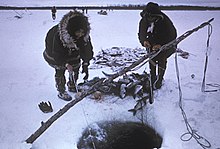| Revision as of 20:17, 30 July 2011 editInnotata (talk | contribs)Autopatrolled, Extended confirmed users, File movers, Pending changes reviewers, Rollbackers43,065 edits →Distribution and taxonomy: another image← Previous edit | Revision as of 05:19, 27 March 2012 edit undoMastiBot (talk | contribs)Extended confirmed users62,165 editsm r2.7.2) (Robot: Removing vi:InconnuNext edit → | ||
| Line 59: | Line 59: | ||
| ] | ] | ||
| ] | ] | ||
| ] | |||
Revision as of 05:19, 27 March 2012
| Stenodus leucichthys | |
|---|---|

| |
| Scientific classification | |
| Kingdom: | Animalia |
| Phylum: | Chordata |
| Class: | Actinopterygii |
| Order: | Salmoniformes |
| Family: | Salmonidae |
| Subfamily: | Coregoninae |
| Genus: | Stenodus Richardson, 1836 |
| Species: | S. leucichthys |
| Binomial name | |
| Stenodus leucichthys (Güldenstädt, 1772) | |
Stenodus leucichthys is a species of freshwater whitefish in the family Salmonidae. It is also known variously by the common names sheefish, inconnu, connie, nelma and beloribitsa. There are two subspecies, sometimes considered distinct species, one of which lives in Eurasian and North American rivers of the Arctic basin, the other in the landlocked Caspian Sea basin. If only one species is recognised, Stenodus leucichthys is the only member of the monotypic genus Stenodus.
Description
The fish has a large mouth with a protruding lower jaw and a high and pointed dorsal fin. It is generally silver in color with a green, blue or brown back. The meat is white, flaky and somewhat oily. An adult fish weighs from 14 to 25 kilograms (31 to 55 lb).
The fish eat plankton for their first year of life and then become predators of smaller fish. They live in lakes and rivers and in the brackish water at the outlets of rivers into the ocean, and may migrate 1,500 kilometres (930 mi) to spawn.
Distribution and taxonomy

The species Stenodus leucichthys can be divided into two geographical subspecies. In recent literature these have also been considered as separate species, a treatment followed by the IUCN Red List, whereas other sources still make no distinction.
- Stenodus leucichthys leucichthys (Güldenstädt, 1772), the nominate subspecies, is found only in rivers draining to the Caspian Sea, such as Volga and Ural in particular. This subspecies, known as the beloribitsa, is now extinct in the wild.
- Stenodus leucichthys nelma (Pallas, 1773), known as the nelma, is found in rivers draining to the Arctic basin in North-East Europe, northern Asia and North America.
Conservation
Fish of the nominate subspecies used to inhabit particularly the Volga, Ural and Terek rivers, and migrate up to 3,000 kilometres (1,900 mi) upstream from the Caspian to their spawning grounds in the spring. Following the construction of dams and hydropower reservoirs, the migration and natural reproduction has been impeded, and the taxon is now considered as extinct in the wild by the IUCN. The stock however survives in hatcheries and some populations are maintained by stocking.
References
- ^ Belyaeva, E. S. "Stenodus leucichthys leucichthys". caspianenvironment.org.
- ^ Kottelat, M.; Freyhof, J. (2007). Handbook of European Freshwater Fishes. ISBN 978-2-8399-0298-4.
- ^ Template:IUCN
- Template:IUCN
- "Stenodus leucichthys". Integrated Taxonomic Information System. Retrieved July 15, 2007.
- Froese, Rainer; Pauly, Daniel (eds.). "Stenodus leucichthys". FishBase. July 2011 version. While FishBase still has an entry for only one species of Stenodus, it states that a page for the other one will be added in future.
External links
- "Mackenzie River Ecosystem: A Dynamic Delta: Inconnu: The "Unknown" Fish" GreatCanadianRivers.com
- Stenodus leucichthys nelma Illustration by N.N. Kondrakov. NOAA Photo Library.